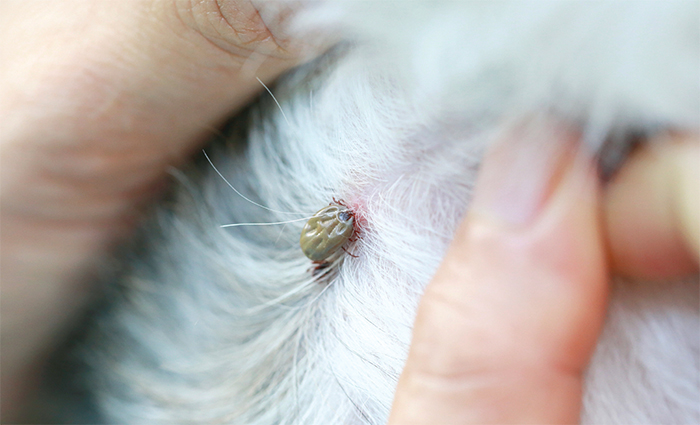Clinical

Pet hates: A look at common veterinary ailments
In Clinical
Let’s get clinical. Follow the links below to find out more about the latest clinical insight in community pharmacy.Bookmark
Record learning outcomes
More needs to be done to inform pet owners about the importance of year-round preventative parasite treatments

Learning objectives
After reading this feature you should be able to:
• Identify common parasitic conditions that affect domestic pets
• Raise awareness of the importance of regular preventative healthcare for customers’ pets
• Merchandise a dedicated fixture and advise owners about OTC animal medicines
According to a wellbeing report by the People’s Dispensary for Sick Animals (PDSA), 32 per cent of dog owners and 35 per cent of cat owners don’t regularly check their pet for fleas, mites or ticks. Sixteen per cent of dogs and 23 per cent of cats aren’t wormed and 21 per cent of dogs and 19 per cent of cats aren’t treated for fleas.
According to the report, 49 per cent of UK adults own a pet (25 per cent have a cat and 24 per cent a dog). With an estimated half a million pet owners visiting a community pharmacy every day, pharmacy teams can provide suitable products and offer information and advice on how to use them properly.
So let’s consider some of the questions pet owners may ask about common animal infestations. The answers are supplied by veterinary experts.
Can I buy preventative parasite treatments from a pharmacy without speaking to a vet first?
It is extremely important that pets are treated regularly with suitable preventative products for problems such as flea infestations. There are many products available but only ‘spot on’ sprays, tablets and injections are effective long-term methods. Many pet owners will speak to a vet about preventative treatments, but pharmacists and pharmacy staff members can be trained and registered to provide POM-VPS medicines for animals not under their care.
PDSA vet Olivia Anderson-Nathan recommends that pharmacy customers always use a prescription (POM-V or VPS) flea product from a veterinary practice or pharmacy, or from a locked cabinet in a pet shop. “These are trialled and tested very rigorously and generally have a good safety profile and proven efficacy,” she says.
Effective spot on products available over-the-counter from pharmacies include the Frontline and Advantage ranges.
Is it necessary to apply flea prevention products to pets all year round?
Many people associate fleas with spring or summer when the weather is warmer and pets are more likely to be outdoors. However, fleas can be present at any time, so pets need preventative treatments throughout the year.
“Fleas would usually decrease in the colder winter months but with modern central heating in homes there is the perfect environment for fleas to breed all year round,” says Street Paws volunteer and locum vet Alison Price in Stockton-on-Tees.
Some dog flea treatments contain insecticides that can be lethal to cats
Can I use the same flea product on my cat, dog and rabbit?
It can be dangerous – and possibly even fatal – to use a product designed for one species on another. “All animals have different physiologies, so chemicals affect them in different ways,” says vet Clare Hamilton, managing director of Hamilton Specialist Referrals, a new pet referral hospital in High Wycombe. “Many flea treatments contain toxins to kill fleas on certain animals. Some dog flea treatments, for instance, contain insecticides that can be lethal to cats.”
Olivia Anderson-Nathan says that pharmacy teams should be extra vigilant as some companies may offer flea products under the same brand name for different species. “Take care when supplying these products and have a protocol in place to ensure that the product for the correct species is given to the customer to avoid any risk of harm,” she says.
Can my pet be bathed, go out in the rain or go swimming straight after using a topical product?
Most topical products and collars recommend keeping a pet dry for a certain period after application, says Anderson-Nathan. “This can vary between a couple of hours and several days, depending on the product, so check the Summary of Product Characteristics (SPC) or data sheet or contact the manufacturer to find out about a specific product,” she says. “If a pet needs regular shampooing or likes to swim often, it may be better to use an oral alternative.”

Can I stroke or touch my pet after using a topical preventative treatment?
Clare Hamilton advises pet owners to avoid handling their pet until the site of application is completely dry. “This will reduce the risk of toxins spreading,” she says. “Flea, tick and worming treatments contain chemicals that can cause side-effects or be harmful if they come into contact with human skin.”
Young children, in particular, should be kept away from the pet being treated, and anyone with a chronic skin disease or allergy will need to take extra care. All owners should wash their hands thoroughly after applying a topical medicine.
Can flea and worming products be used in pets with chronic medical conditions or on other medication?
“Vets usually recommend keeping up a preventative regimen in pets with chronic conditions or those on other medication, especially if the pet’s condition is stable,” says Olivia Anderson- Nathan. “However, owners should speak with their vet before using any other medications or pet products, so they can recommend appropriate products that won’t exacerbate or interact with their existing condition or medications.”
If a pet has a skin condition, the owner should speak to a vet before using a topical treatment, as they may need to use oral medication instead.
Extra help provided
Many pet owners will visit a vet only once a year for their pet’s annual check-up – but not all pharmacy customers can afford to visit a vet, even when their pet is unwell. To qualify for services from the People’s Dispensary for Sick Animals (pdsa.org.uk), pet owners need to be in receipt of eligible benefits and live within the postcode catchment area of a PDSA pet hospital or clinic.
The Street Paws charity provides free veterinary care and emergency kennels to animals owned by people who are homeless, vulnerably housed or other vulnerable groups severely affected by poverty.
Are there any other pets (other than cats/dogs/rabbits) that may require preventative parasite treatments?
Most pets, including guinea pigs, hamsters, gerbils and mice, can be prone to parasites and will need preventative treatments. Pet reptiles, such as bearded dragons and corn snakes, which are becoming increasingly popular in the UK, can be prone to parasitic infestations, so customers should speak to a vet about suitable products.
“It is important to have a reptile assessed by a herpetological vet before using any over-the-counter preventative treatments, as many concentrations can be toxic to snakes and lizards,” says Sophie Jameson at Wild Science, handlers of exotic animals and providers of animal workshops and therapy sessions. “Once customers know the concentration or products suitable for their pet, they may be able to get these items from their pharmacist in the future.”
Pets should be wormed every three months, but depending on individual risk, more frequent application may be advised
What are the symptoms of worm infestations in cats and dogs?
Worm infestations don’t always cause any symptoms. When they do occur, they often vary according to the type of worm involved, say Alison Price. These symptoms may include weight loss, vomiting, diarrhoea, a pot-bellied appearance, lethargy, loss of body condition and, in some cases, coughing.
Olivia Anderson-Nathan stresses that some worms (e.g. toxocara) can be a risk to human health as well. “Rather than waiting for signs of worms, it is better to use a regular worming treatment to prevent problems,” she says. “Pets should be wormed every three months, but depending on individual risk, more frequent application may be advised (e.g. to cover against lungworm, monthly administration of a product may be required).
"A wormer with coverage against both tapeworms and round and hookworms should be used. Coverage against lungworm should be considered based on local and lifestyle risk. If the risks are unclear, a vet will be able to advise which product is best for a pet and how often it needs to be used.”
How would I know if my pet has fleas?
Some pet owners may notice a change in behaviour, rather than visible signs on their pet’s fur or skin. However, not all pets have symptoms, which is why regular prevention is important.
“Unusual, red patches on the skin is often a sign,” says Clare Hamilton. “This is usually caused by an allergic reaction to the fleas. Dogs also start abnormal scratching, licking and biting to try to relieve the pain of the fleas. In severe conditions, hair loss is also visible due to the continuous licking and biting of flea bite areas. Be aware that cats can hide symptoms of fleas very well, so if in doubt use a flea comb to check.”
Key facts
• It can be dangerous to use a product designed for one species on another species
• A wormer with coverage against both tapeworms and round and hookworms should be used
• Pharmacy staff can approach the subject of pet health by relating it to the health of their customers.
How can I get rid of a flea infestation in my home?
It is estimated that 95 per cent of flea eggs, larvae and pupae live in the environment, not on a pet. “If a dog has 50 fleas living on it, the house would have nearly 1,000 flea eggs and fleas in the furnishings,” says Olivia Anderson-Nathan.
“Use a household flea spray regularly. A suitable product can be applied to carpets and flooring, is safe once dried for pets and people, and has a long efficacy – ideally six months or more. If someone has cats, make sure the spray doesn’t contain permethrin, which is toxic to them. Pay special attention to the places where a pet spends a lot of time, like the sofa or bed, as well as around fires and radiators. Fleas love these warm areas.”

What is flea allergy dermatitis?
Fleas cause itching for most pets, but some pets develop an allergy to flea saliva, called flea allergic dermatitis (FAD). This can cause intense itching and inflammation. If customers suspect that their pet has FAD, they should speak to their vet about suitable treatments.
“With FAD, animals are bitten by a flea, and the contact with flea saliva causes an allergic response on the animal’s skin,” says Alison Price. “It is very itchy and can cause redness and severe hair loss due to self-trauma. FAD often requires strict treatment regimens to prevent flare-ups.”
Is it possible to prevent dogs from picking up ticks?
Ticks are more common in woodland and moorland areas, but can also be picked up in local parks or gardens, especially where the grass is long. Hedgehogs and foxes are common tick carriers, meaning pets in urban areas with high fox populations are also at risk. If ticks are a problem in local areas, customers should try to avoid walking their dog in grassy places and stick to paths.
“To prevent dogs from picking up ticks, always check the body when returning from a walk,” says Clare Hamilton. “Brushing fur prevents ticks from attaching themselves to the pet. Using regular tick treatments will also repel ticks and kill them if they do attach to the fur. Oral medications are available from a vet. These can be given to dogs monthly, not only to kill ticks and fleas, but also to disrupt the life cycle of ticks.”
Can ticks be harmful to humans as well?
Tick bites aren’t usually painful in humans, but can cause itching, inflammation and blistering. Ticks should be removed as soon as possible if they are found on the skin (pet or human). This can be done using fine-tipped tweezers or a special tick removal tool, grasping the tick as close to the skin as possible, taking care not to squeeze or crush it.
Ticks can be infected with a bacterial infection called Lyme disease, which is then transmitted to humans following a bite. This causes a distinctive circular red rash around the bite, which looks like a bull’s eye on a dartboard. The rash can appear up to three months after being bitten. Other symptoms of Lyme disease include fever, headaches, fatigue, and muscle and joint pain.
If pharmacy customers have signs of Lyme disease, they should see their GP as soon as possible. It is usually treated with a three-week course of antibiotics.
Expanding pharmacy’s role in pet health
If community pharmacies want to be more involved in the supply of pet medicines they can do so in several ways, depending on whether pharmacists wish to become qualified to prescribe pet medicines or just sell OTC medicines and other animal health products.
“The first step is being keen to engage pet owners as part of their customer base,” says PDSA vet Olivia Anderson-Nathan. “Find out if customers have pets, enquire about their general health, and ask about flea and worming regimens. Pet owners represent a big opportunity for pharmacy as they are often looking for information all over the place but have difficulty finding trusted sources.”
POM-V medicines can only be prescribed by a vet after a full clinical assessment, but can be dispensed by a pharmacist. POM-VPS medicines can be prescribed by a Registered Qualified Person (RQP, including pharmacists) or an appropriately qualified Suitably Qualified Person (SQP), without the need for a full clinical assessment of the animal.
“Sufficient information about the animal and the way it is kept must be known by the prescriber in order to prescribe and supply appropriately,” says Anderson-Nathan. “For flea, tick and worming treatments, this would usually include the weight of the animal and the risk level of the pet based on its lifestyle, so that a product with the right dose, interval and covering the right parasites can be recommended.
“The National Office of Animal Health (NOAH) keeps a compendium of licensed veterinary medicine datasheets that can be ordered as a book or referenced online. Anyone can train to be a SQP, so any staff that are keen might be good candidates for the qualification. The Animal Medicines Training Regulatory Authority (AMTRA) is in charge of training, accreditation and registration.”
Topical issues
Pharmacies can also sell NFA-VPS medicines (equivalent to P medicines) and AVM-GSL medicines. To engage with customers, it is important to keep up-to-date on topical issues. PDSA research revealed recently that 46 per cent of dogs, 34 per cent of cats and 30 per cent of rabbits are believed to be overweight or obese, caused by overfeeding and not providing enough exercise. Excess weight can lead to health problems such as arthritis and diabetes.
Behaviour is another topical issue. Recent research commissioned by Ceva Animal Health shows that 77 per cent of owners say they regularly change their routines to accommodate anxious pets, with 48 per cent saying they believe difficult behaviour is due to anxiety and fear.
Olivia Anderson-Nathan advises pharmacists to approach local vets to create a good working relationship. “Speak to them about which medications to stock to make sure no toes are stepped on, and they may be able to help with areas that require special training,” she says.
“Veterinary specialist pharmacists are few and far between. Most clinics dispense their own medications, but will be keen to support pharmacists who wish to become good sources of information and effective treatments. Regional drug reps will be able to provide training and information on animal health products to improve confidence in this area.”
If pharmacies wish to stock animal healthcare products, it is important to ensure that these have a proven evidence base. “If products make health claims, such as improving skin, joint or dental health, check that they have the claimed efficacy,” says Anderson-Nathan.
“For example, for dental products, the Veterinary Oral Health Council has an accreditation scheme for products that claim to reduce plaque and/or tartar, which checks that appropriate evidence is provided to back up any claims. The PDSA has its own Vet Care range of supplements, ear cleaners, probiotic paste and dog shampoo.”
